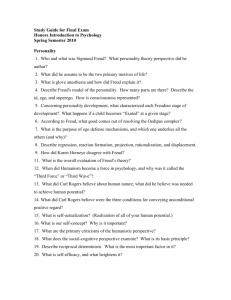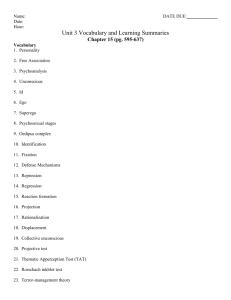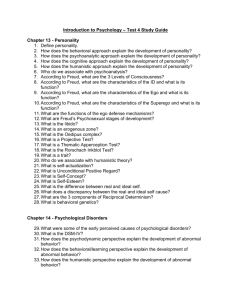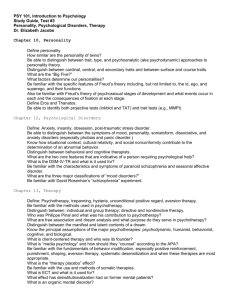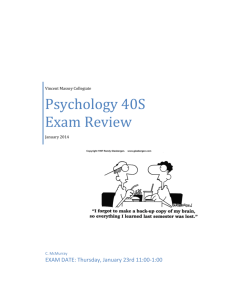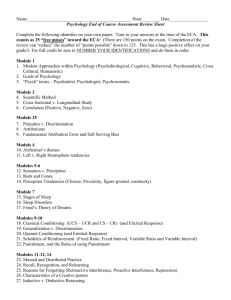PSYC 1101: Study Guide for Test 4
advertisement
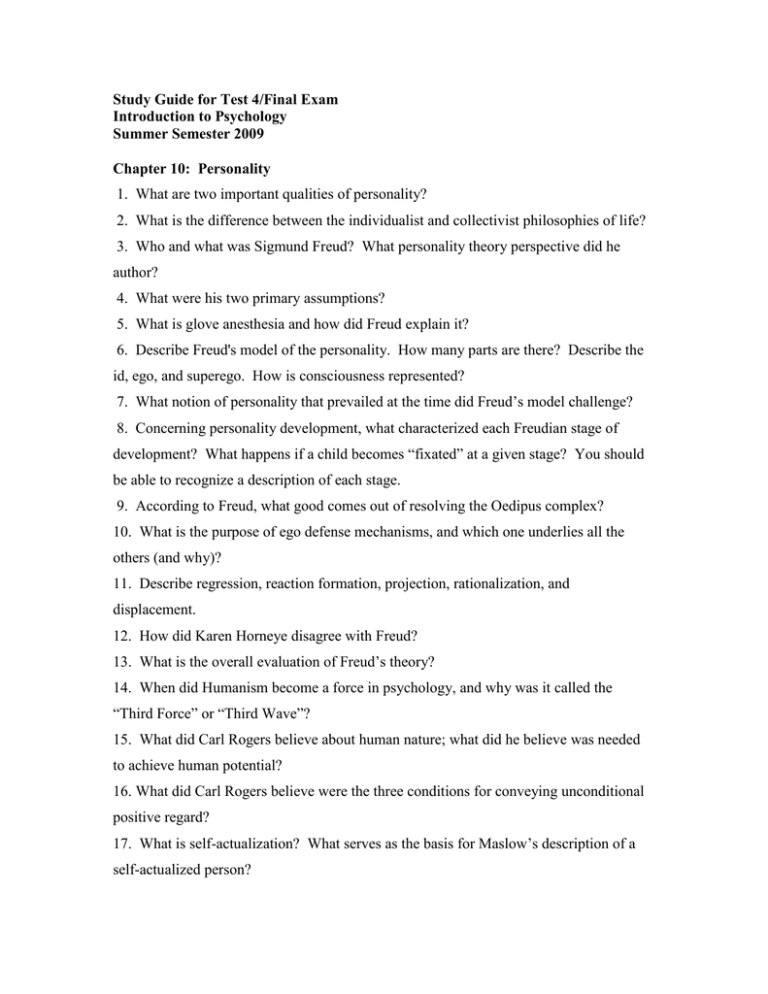
Study Guide for Test 4/Final Exam Introduction to Psychology Summer Semester 2009 Chapter 10: Personality 1. What are two important qualities of personality? 2. What is the difference between the individualist and collectivist philosophies of life? 3. Who and what was Sigmund Freud? What personality theory perspective did he author? 4. What were his two primary assumptions? 5. What is glove anesthesia and how did Freud explain it? 6. Describe Freud's model of the personality. How many parts are there? Describe the id, ego, and superego. How is consciousness represented? 7. What notion of personality that prevailed at the time did Freud’s model challenge? 8. Concerning personality development, what characterized each Freudian stage of development? What happens if a child becomes “fixated” at a given stage? You should be able to recognize a description of each stage. 9. According to Freud, what good comes out of resolving the Oedipus complex? 10. What is the purpose of ego defense mechanisms, and which one underlies all the others (and why)? 11. Describe regression, reaction formation, projection, rationalization, and displacement. 12. How did Karen Horneye disagree with Freud? 13. What is the overall evaluation of Freud’s theory? 14. When did Humanism become a force in psychology, and why was it called the “Third Force” or “Third Wave”? 15. What did Carl Rogers believe about human nature; what did he believe was needed to achieve human potential? 16. What did Carl Rogers believe were the three conditions for conveying unconditional positive regard? 17. What is self-actualization? What serves as the basis for Maslow’s description of a self-actualized person? 18. What is our self-concept? Why is it important? 19. What are the primary criticisms of the humanistic perspective? 20. What does the social-cognitive perspective examine? What is its basic principle? 21. Describe reciprocal determinism. What is the most important factor in it? 22. What is self-efficacy, and what heightens it? 23. What is internal vs. external locus of control? Describe internal vs. external locus of control? Which leads to more independence and success? 24. Is the social-cognitive perspective based on scientific testing? What is its primary weakness? Chapter 11: Psychological Disorders 1. What are the three major criteria used to define psychological disorders? 2. What are the differences among the medical, diathesis-stress, and bio-psycho-social models of mental illness? 3. How does each of the five primary perspectives in psychology describe the cause of mental disorder? 4. What are two disadvantages of labeling people as mentally disordered? 5. What is the DSM-IV-TR, and who publishes it? What is it used for and what type of information does it contain? On what are its diagnostic criteria based? 6. What is the chief characteristic of anxiety disorders and about what percentage of the population will experience one? 7. Describe the five major anxiety disorders (panic, phobic, GAD, OCD, and PTSD. ) You should be able to recognize some common obsessive-compulsive themes. 8. What is the most common mood disorder? 9. You should be able to recognize the physiological, behavioral, and cognitive symptoms of major depressive disorder? 10. What are the four factors in the cycle of major depression? Does the U.S. have the highest instance of depression? 11. How does bipolar disorder compare with major depression? What is a manic episode or mania? 12. What is the major danger with depression? What are some reasons that women may be diagnosed more often with depression than men? 13. With each new generation the rate of depression is increasing/decreasing and the disorder is striking earlier/later. 14. What is Dissociative Identity Disorder? What was its former name? Why was it changed? Why is it sometimes thought of as a therapist-induced symptom pattern? 15. What are the characteristic of schizophrenia? What are delusions? What are hallucinations? What are the risks of developing schizophrenia? 16. What are personality disorders? Describe the paranoid, histrionic, and narcissistic personality types. Describe the antisocial personality. What is a physiological characteristic of this disorder? Chapter 11: Treatment for Psychological Disorders 1. What are the two major categories of therapy for psychological disorders? What are the three central mental health professions? What are the two specialty areas in psychology that deal with mental illness? 2. What are psychodynamic therapy and psychoanalysis? From whose theory were these derived? You should know what free association, resistance, and transference are. What is the goal of psychoanalysis? 3. Where do the assumptions and techniques of behavior therapy come from? 4. What is counterconditioning and what is systematic desensitization? 5. Why does aversion therapy not work very well? 6. What is the focus of humanistic therapies? What (and whose) is client-centered therapy? 7. What is the assumption and what is the focus of cognitive therapy? 8. What is REBT? What is CBT? Who are the authors of these therapies? What is the best kind of therapy for phobias? 9. What is currently the most popular type of therapy? 10. What is group therapy, and what is a self-help group? 11. What type of professional do most people seek when they have a problem? 12. Does research indicate that therapy works? What does outcome research compare? Why is therapy difficult to evaluate? 13. What are alternative therapies? 14. What are three important elements that are common to all types of psychotherapy? 15. What is one consideration that should always be included in determining patienttherapist match? 16. What is psychopharmacology? 17. What happened to mental hospitals when psychotherapeutic drugs were introduced? 18. What neurotransmitter is targeted by an antipsychotic drug? What are their effects? 19. What is the chief criticism of the antianxiety drugs? 20. What are the classes of antidepressant drugs? Name two SSRI drugs. What other disorders are they used for in addition to depression? 21. What is lithium used for? What is ECT supposed to be used for? What is the chief side effect of ECT? 22. What is psychosurgery? What is a lobotomy? What is the result of a lobotomy for the patient's behavior? Chapter 13: Social Behavior 1. Social psychology is the scientific study of what? What is social perception? 2. What is attribution? What is the first step in impression formation? What are the most common features used to categorize people? How can social categorization lead to stereotyping? 3. What is the difference between prejudice and discrimination? Is there any such thing as unconscious prejudice? 4. Can the prejudice habit be broken? 5. What is the difference between an internal and an external attribution? What is the fundamental Attribution Error? 6. What is an attitude? What is the mere exposure effect? 7. What is persuasion? Describe the elaboration likelihood model. What is the difference between high and low elaboration? 8. Can attitude change occur without comprehension? Compare attitudes formed through central and peripheral processing. 9. How can our behavior change our attitudes? What is cognitive dissonance and what are three ways to resolve it? 10. What is social influence? What are two sources of social power and what are three consequences of exercising it? 11. What is conformity? What are the two types of reasons for conforming? How often did Solomon Asch find people to conform to a temporary group on a clear and unambiguous task? How many people conformed at least once? What is significant about the fact that this happened on an unambiguous task in an experiment? What are some of the factors that influence it? 12. What is obedience? What is authority? What was Stanley Milgram’s true research question? What did he tell the participants that his research question was? How many shocks were actually administered in the course of the experiment? 13. How many “teachers” (what fraction or percentage) were willing to go to 450 volts? 14. What are the key factors in explaining his results? Answers: 1) Participants were will and able to absolve themselves of responsibility. Contributing factors to this were the established mental framework, the context of scientific research, and the experimenter’s reassurances. 2) The gradual, repetitive escalation of the task. 3) The extent to which teachers were able to distance themselves from the learner. The greater the distance, the greater the obedience. 4) Another was being able to watch another teacher refuse to go on. This decreased obedience. 15. Are conformity and obedience bad in and of themselves? 16. What is the key to the decision to help in the bystander effect? (Step 3) 17. What are the two most powerful factors in interpersonal attraction? 18. From Chapter 3 – Who was Erik Erikson? How many stages did he have? Describe the first and last ones.
